Born in the early 1970s in the land of the fjords, Electrocompaniet operates exclusively in the professional audio and high-end High Fidelity equipment sectors, and its products enjoy a great reputation amongst the most discerning audiophiles.
The Norwegian brand had, really, always been a heavy hitter from the outset, developing an amplifier (the 2 Channel Audio Power Amplifier), designed to offer very low transient intermodulation distortion, a problem afflicting a lot of the amplifiers of the time, and which was theorised by the engineers Matti Otala and Jan Lohstroh, who were working in the Philips Research and Development department at the time, in Eindhoven.
This transient intermodulation distortion, or TID, explained the lack of musicality in amplifiers which otherwise boasted very low levels of harmonic distortion: these low levels resulted from the use of a heightened counter-reaction, which made for instability in the amplifiers when transient phenomena (often enough, music) brought about TID.
On the strength of such an entry into the world of High Fidelity, Electrocompaniet then set about shoring itself up for the long term, and today, the producer's catalogue is made up of three ranges of electronics.
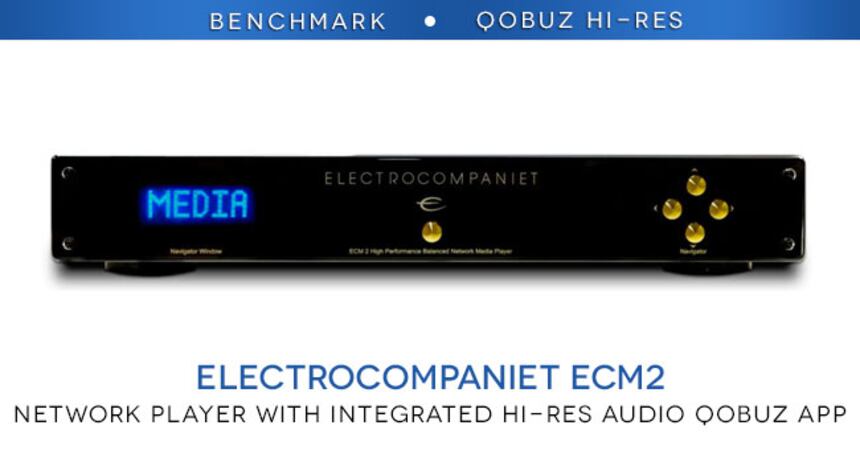
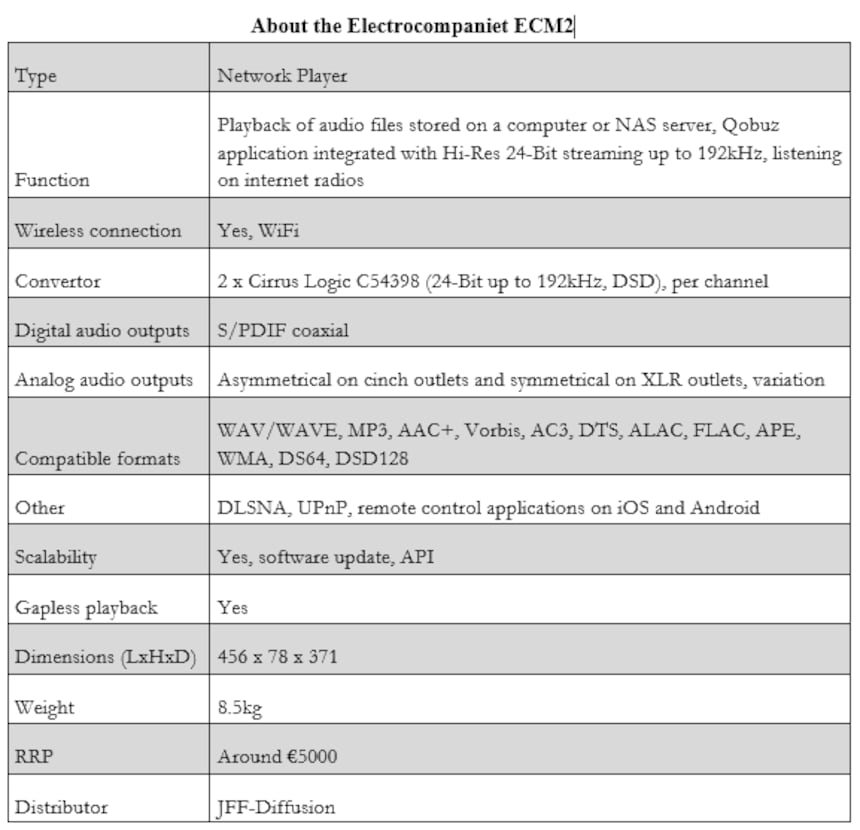
The Electrocompaniet entry-level product line is called Prelude Line(!) and is made up of several sources (CD and Blu Ray reader), a DAC, amplifiers and speakers, and at the pinnacle we have the DP Line, concepts including two amplifiers which deliver colossal power and an uncompromising preamplifier.
Between these two lines, there is the Classic Line, the brand's centrepiece, which contains around 20 devices, including five amplifiers, a preamplifier, six power amplifiers, CD drives and digital sources like the ECM2 network drive, which we are taking to the test bench for you.
This device, which can read 24-bit, 192 kHz Hi Res audio files, comes with the Qobuz App (available 15 June), also in Hi-Res, which is a world first and will allow future buyers, or current ECM2 owners with a subscription to Qobuz Sublime, to read their purchased albums in Hi-Res Audio quality via the internet.
Presentation
While Scandinavian Hi-Fi design, and Danish design in particular, is often cited as a reference point, the Norwegian producer Electrocompaniet appears to somewhat unfamiliar with the finesse of Bang & Olufsen's aesthetics.
In fact, we would venture to describe the appearance of the ECM2 drive as a bit bling, with its big activation buttons, its four navigation buttons and its gilded prints, along with its display, which no-one could accuse of being too small to see!
But all this is a matter of taste, and none of it stops this device from giving off an air of seriousness, and inspiring a measure of respect.

Connectivity
Electrocompaniet hasn't cut any corners when it comes to connectivity - as the device can connect to the network via an RJ45 connection or via wifi; four USB storage devices, hard drives or USB keys can be connected; and as four S/PDIF inputs (two coaxial and two optic) are available too. On top of all that, there is an HDMI input, which can be connected to a television screen or to a multi-channel amplifier, as well as a coaxial S/PDIF output.

The analogue signals are available at variable levels, in an unbalanced mode via the Cinch sockets and in balanced mode via XLR sockets, and we also find a trigger input and output, and a diagnostic socket reserved for maintenance.
Production
The Electrocompaniet ECM2 has quite an imposing electronic array, with two cards, one dedicated to digital functions and the other to conversion and the preamplifier stages, which share half of the surface of the casing.
The other half is a little less crowded, since in the basic model it only receives the toroidal transformer power supply. In the central part, a hard disk can be installed in order to store digital audio files.
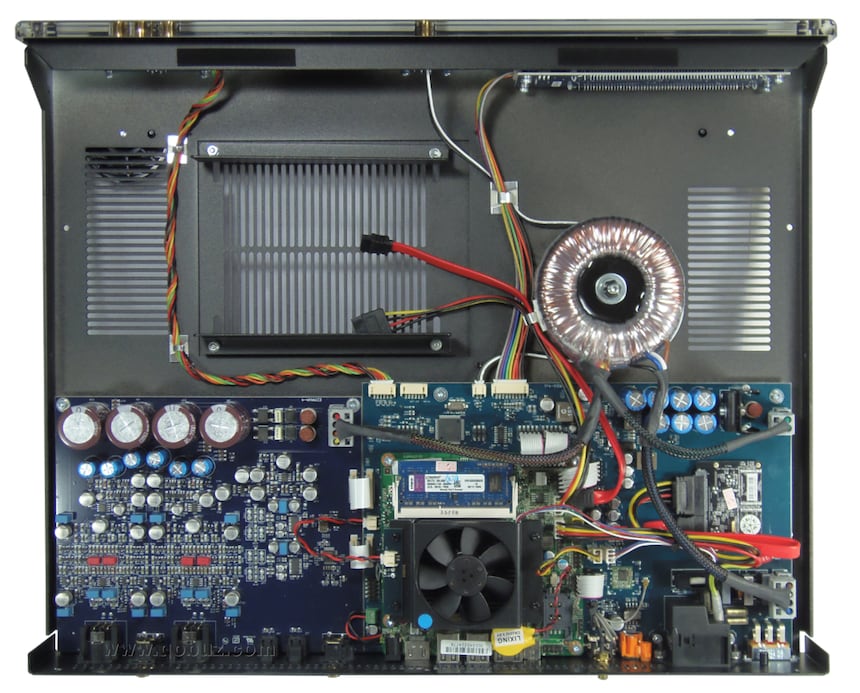
The digital card has its own +5V power supply, made using an independent transformer coil, so as not to interfere with the power supply for the analogue section and its filter calls for a battery with seven electrolytic capacitors of 2200 ?F/25V, which provides some assurance!
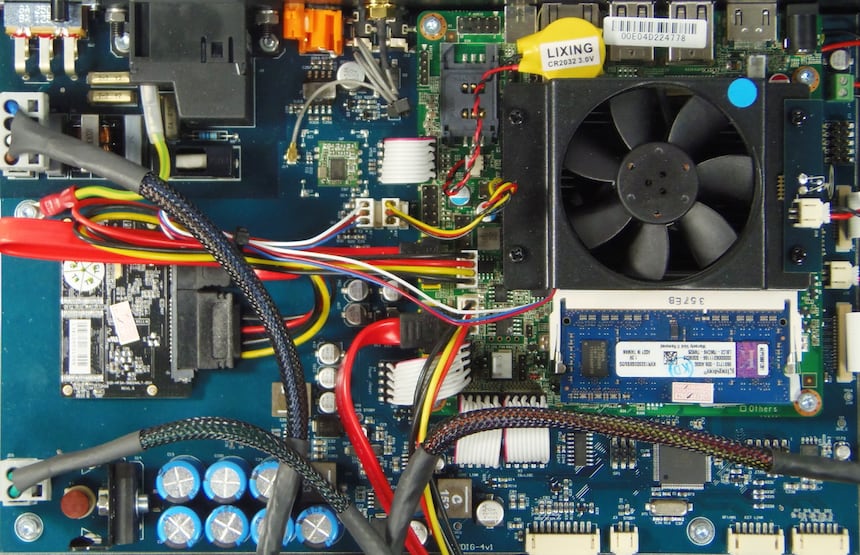
At the heart of this digital card, there is a multimedia Yacoo DS-2018 which guarantees the interface with the network and the USB A inputs and which control the HDMI output.
This card contains a LAN Realtek 8111DL controller as well as an HD Realtek ALC662 audio controller which can decode 5.1 flux audio in High Definition (and therefore in stereo) and provides an S/PDIF digital output. It is linked by SATA cable to as SSD static hard disk (left side of the picture) and its processor is cooled by an ultra-quiet ventilator.
The wifi module can be seen on the left hand side of, and connected to, the Yacoo DS-2018 card.
Power supply to the analogue part is made up of several AC voltages and the rectifier filtration is very serious, being composed of four 2200 ?F/80V capacitors.
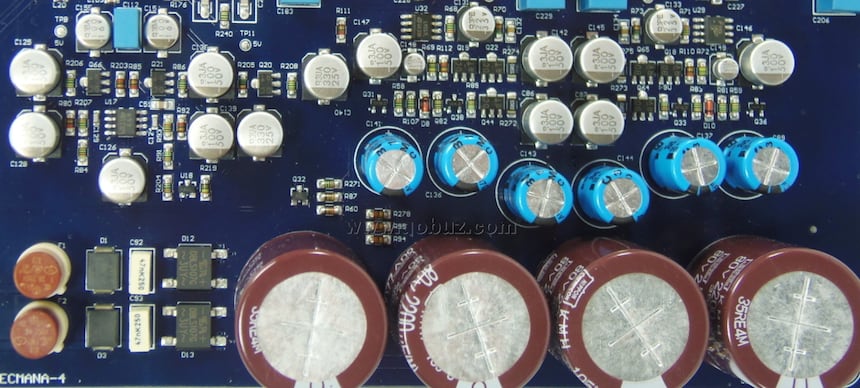
Some of these AC voltages are stabilised, and we notice that there is an LM317 positive adjustable regulator in a casing mounted on the surface linked to the transistors, to increase their current capabilities, as well as an analogous structure with an LM337 negative adjustable regulator.
On the left side can be seen the +5V supply feeding into the converter chips, using a transistorised circuit with an LM317 adjustable regulator.
The signals coming from the network card are confined to a Burr Brown SRC4392 sampling rate converter chip which will requantise them to 24 bits at 192 kHz, regardless of their frequency and their original number of bits.
These signals will then be processed by two Cirrus Logic CS4398 digital analogue converters (one per channel), which deliver differential signals in voltage on each line.
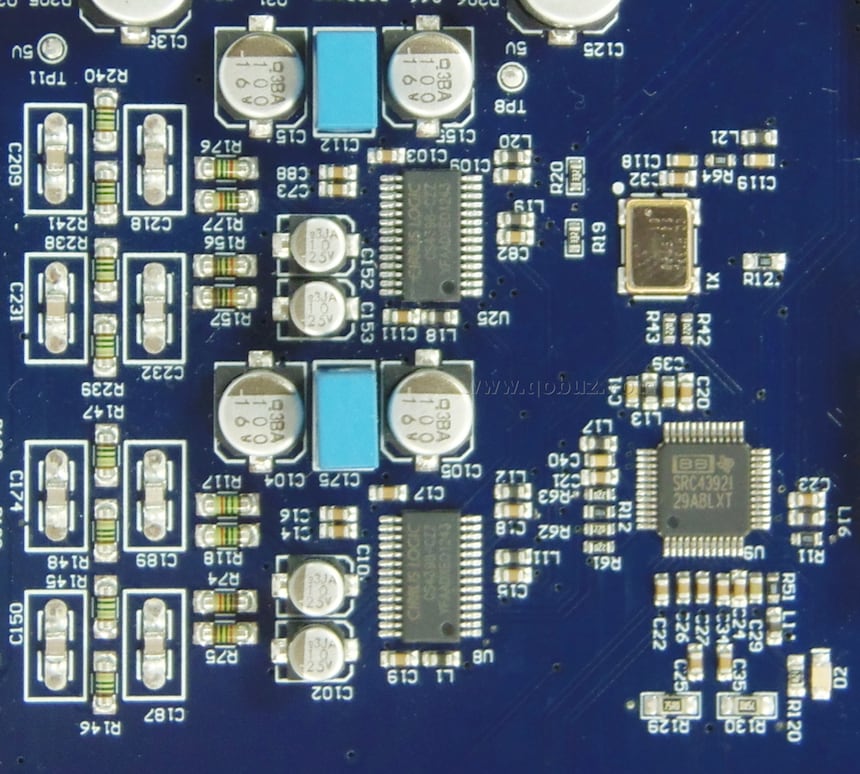
In order to ensure that impact on sound quality, if any, is minimal, Electrocompaniet does not use an active filter with operational amplifiers to clean these differential signals, but instead uses simple passive filters. It will be noted in this connection that the circuit design as printed envisions the possibility of mounting traditional capacitors on plastic plates, instead of surface-mounted models (see left-hand side of photo).
The balanced pre amplification is made up of discrete components, including transistors, precision resistors on metal plates and capacitors on plastic plates, in order to obtain an optimal sound quality (photo of a single channel).
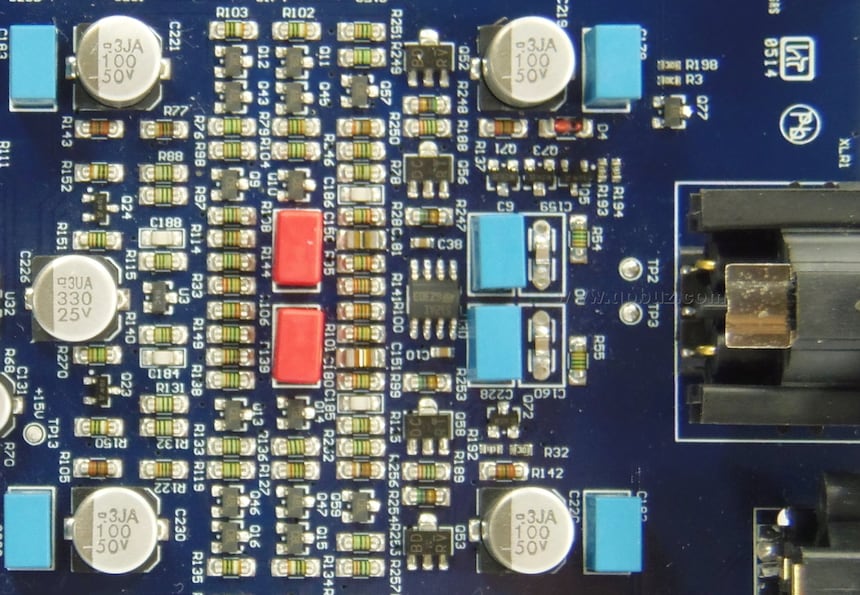
We note a TS512 operational precision amplifier, manufactured by STMicroelectronics, but there is every reason to think that this is used to maintain the DC voltage at 0V at the preamplifier output (a circuit which is known as active offset compensation).
The balanced signals come in via the XLR sockets while the positive part of these signals can be found via the Cinch sockets.
Use, listening
We invite you to take a look at a few screenshots from the Qobuz App.
- welcome screen for the Audio option in the ECM2 network drive menu, where the Qobuz App is to be found
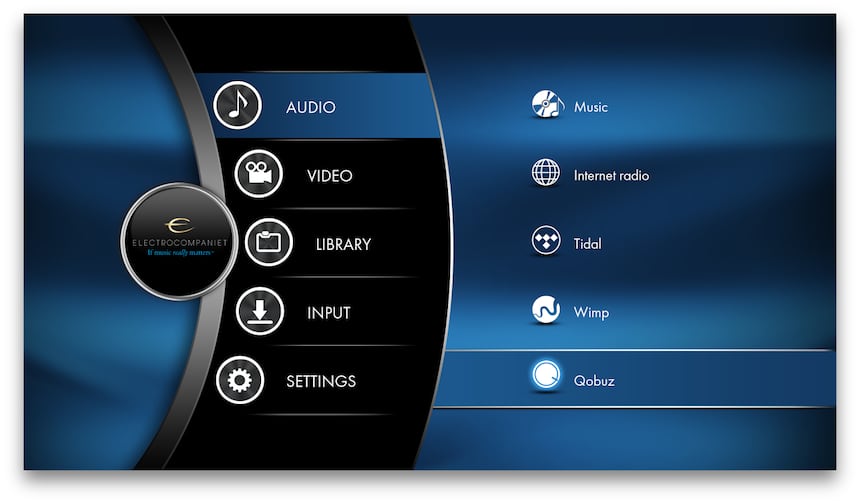
- welcome page for the Qobuz App (for Hi-Res streaming, a subscription to Sublime is needed)

- options on the Albums tab
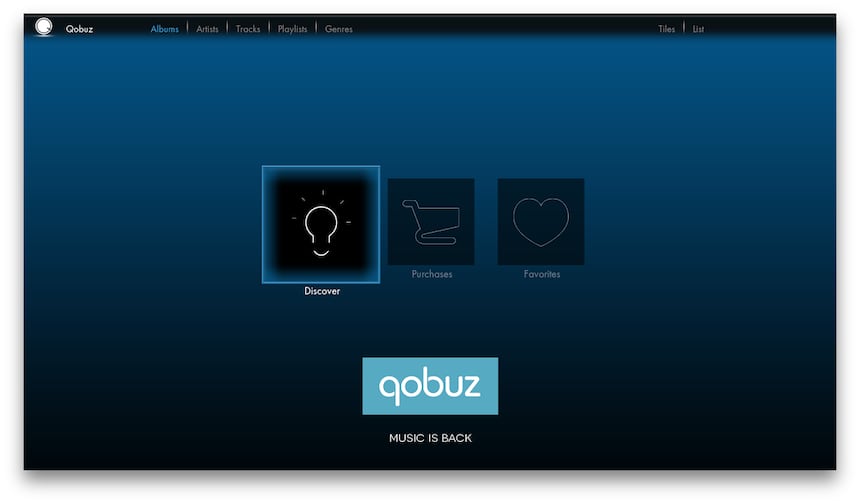
- choices with the Discover option
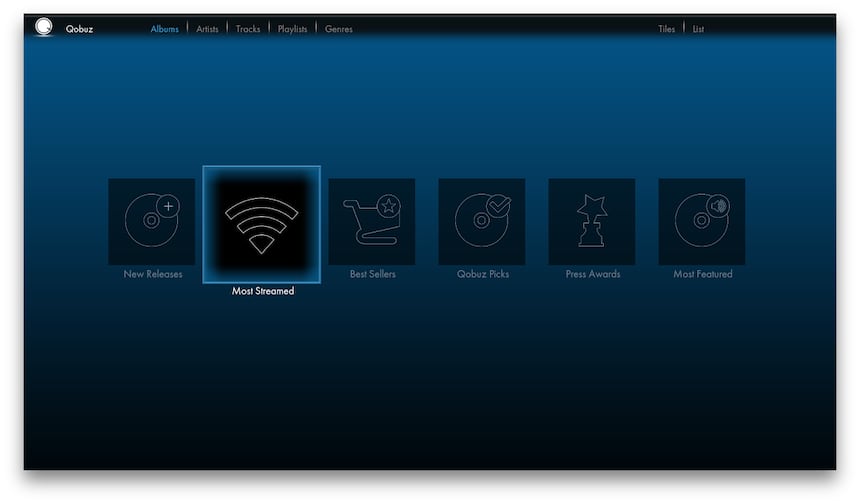
- confirmation of Most Streamed selection
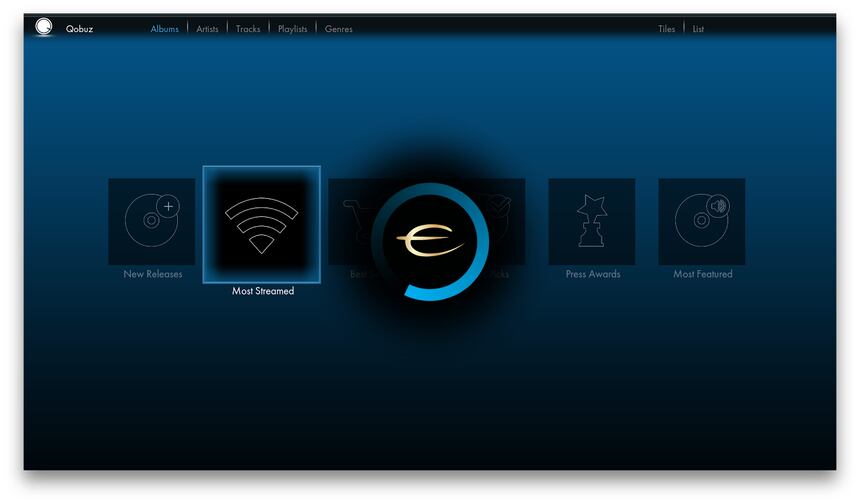
- cover displays of most-streamed albums
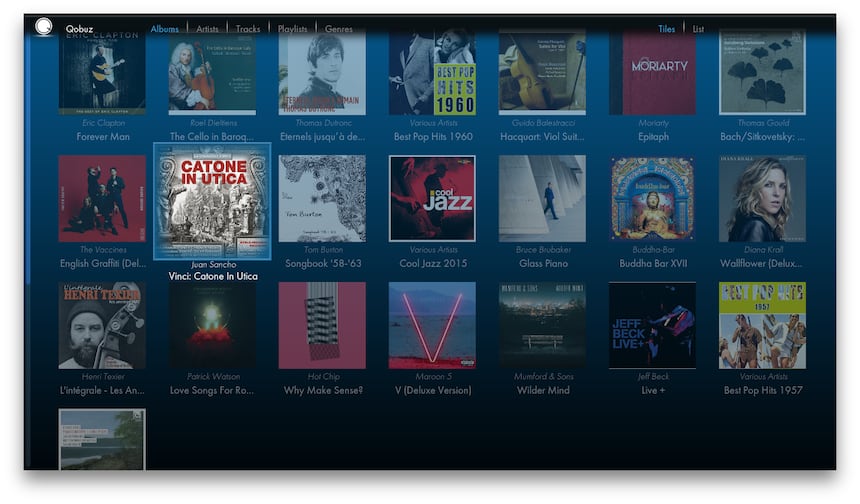
- Playback of a Hi Res Audio album
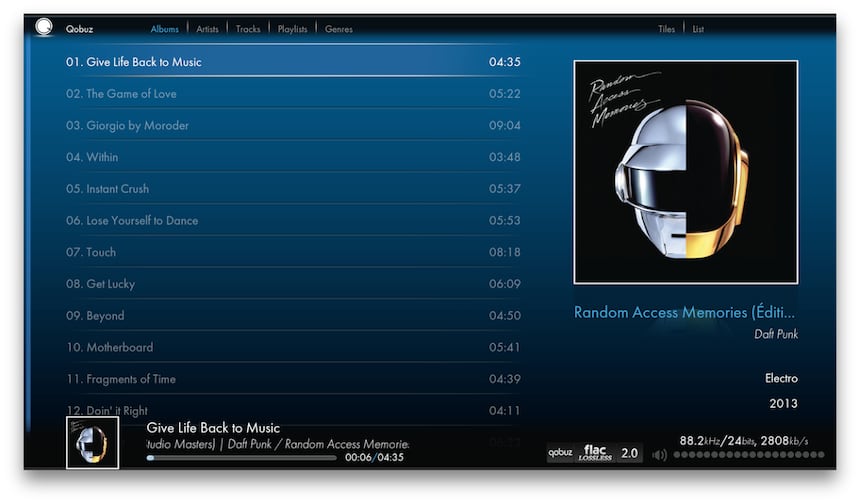
When we found the Burr Brown SRC4392 sampling rate conversion chip in the electronics of this Electrocompaniet ECM2 network drive, we immediately began to fear the worst in terms of its impact on sound quality.
This type of signal treatment has never really been to our taste, and while many producers can use it to boast of better figures than those achieved with files in their original form, the sound often takes on a certain polish, which is pleasant to be sure: but we often find it has an artificial sheen.
But Electrocompaniet didn't see it the way we did, and the ECM2 network drive provides a very good sound, shimmering and full, calmly avoiding any excess at the top of the range (if anything, rather on the contrary).
So, when listening to extracts from the album Vespri per l'Assunzione di Maria Vergine by Vivaldi, with Rinaldio Alessandrini conducting the Concerto Italiano, we are afforded a very nice audio performance from the Electrocompaniet ECM2, but without this biting extreme, and this briskness which we know well, meaning that it has a beneficial effect on the voices, protecting them from any stridency, while expressing themselves clearly.
With the number Chaleur Humaine from the album Chaleur humaine by Christine and the Queens, we are rewarded with a particularly smooth sound, where the singer's voice almost fuses with the accompaniment, which pulses with deep bass notes, and while the overall result might be said to lack a little relief, it is nevertheless very charming.
Rather than a hot summertime sunrise, it is a soft and pleasant Spring morning to which we are treated by the the luminous Symphonie N°8 by Dvorak and the Malaysian Philharmonic Orchestra under the direction of Claus Peter Flor (Hi-Res version, 24 bits at 44.1 kHz), and the ECM2 provides a pretty accomplished, fluent rendition.
The hard-hitting Papaoutai from the album Racine carrée by Stromae is given a clear, precise sound reproduction by the ECM2 network drive, in which the singer's voice has good presence without being too incisive, and remaining clearly intelligible throughout. Maybe it comes across a little bit "Stromae light", but it works very well.
To conclude, the Electrocompaniet network drive positions itself comfortably among other top-of-the-range Hi Fi devices, and offers a sophisticated electronic system. The analogue part, entirely made up of discrete components, offers a balanced preamplifier with a sweet sound, which is gently, pleasantly reserved. And then, there is the Qobuz App in Hi-Res Audio!
User Manual (in English only)
JFF Diffusion (French Distribution)
Reading capacities
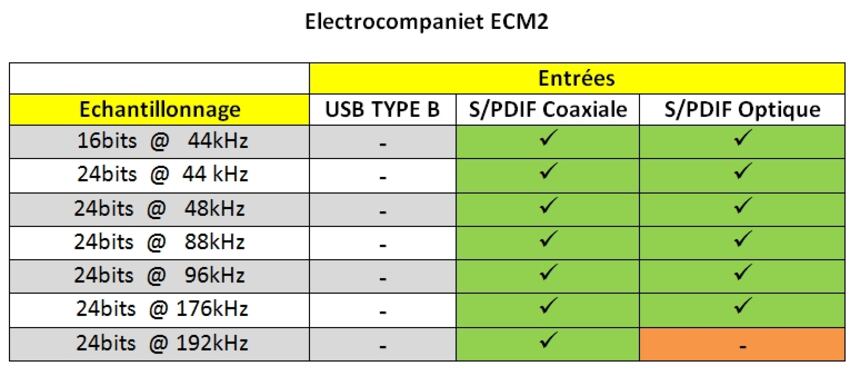
To follow all the latest news from Qobuz, join us on Facebook!
If you are a producer, importer, distributor or actor in the field of sound reproduction and you wish to contact us, please do so at the following address:}} newstech@qobuz.com
If you are a fan of the Hi-Fi Guide and you want to contact us, please do so using the following address: rubriquehifi@qobuz.com

